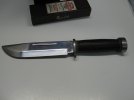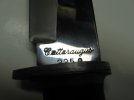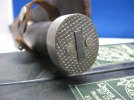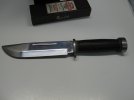This has been in the public domain for years, so I assume it's okay to post it here. This article talks about the issue of whether or not the Cattaraugus #225Q knives were actually issued for the purpose of opening crates, etc. I've seen several other knowledgeable authors state that they believe that the knives were designed with that in mind, but you all will have to decide for yourselves.
__________________________________________
Part 1: The 'Q' Knives of WW II
By Frank Trzaska 2004
The Cattaraugus 225Q and the Case 337Q knives have always intrigued me. Perhaps it is some of the myths that always circulated about them that drew me in. I love the challenge associated with a knife with a mainly oral history. Very little has been written about the Q knives in the way of facts. We can find photos of them in just about every theatre of World War Two being worn by front line fighters yet the myth is that the were issued to Quartermaster personal for opening crates. Just on the surface it sounds ridiculous that a knife would be procured for such a use when crowbars had been in inventory for just such a task. In fact there were even specialized crate opening tools specified for that job in Quartermaster catalogs. The myth grown up around these knives even has the pommel as being designed to hammer the nails back into the crates apparently after the wrong box is opened. It sounds fishy when put into this type of context yet the myth continues to grow and to spread. Like most good urban legends some fact is always present to make the myth palatable to the majority of people. In this article we hope to end some of those urban legends and present the facts associated with the misunderstood and under appreciated Q knives.
At the start of World War Two it is a known fact that the U.S. forces were woefully under prepared to wage a war on this large of a scale. In fact a war this large had never been fought before or for that fact ever since. Many new ventures would be engaged in to meet the production demands of such a large force. Knives were but one aspect of the new style war to be fought. It became immediately known that the U.S. forces were short of cutlery of all types. To meet this demand it was decided to use whatever style could be put into immediate production. The early Marine Corps Raider knives were nothing more then Camillus hunting knives quickly popped out and sent to the newly formed group. Along these same lines the portion of the military tasked with purchasing all types of supplies was the Quartermaster Corps. The Army had their own Quartermaster Corps as did the Navy, both of which cooperated but were usually tasked with much different problems. In this specific task they were both looking for the same type of vendor to produce an item in great need by all branches of the services. Fast production was needed so a style of construction was chosen which would lead to little changes needed by the producing factories. This was a simple matter in choosing a stacked leather handle that had been in continuous production since at least the turn of the century. Other then that simple order any six inch bladed hunting knife would do. Our good friend Carter Rila has made a great distinction between somewhat common words that will come into play with these knives. He distinguishes the word "type" and "pattern" for just such an occasion. A “pattern” is a knife made to a specific design, subtle differences are known to exist but the knife generally follows a pattern. A classic example would be a common USN Mark 2 knife. Made by Ka-Bar, Camillus, Pal and Robeson Shuredge they all look much the same following a specific pattern. A “type” is a knife purchased for a specific general task but not following a specific pattern. A classic example of a type is the USN Mark 1 knife. A five-inch bladed hunting knife that will fit a similar scabbard. The first fixed blade knives procured were of the “type” designation. A six-inch bladed hunting knife with stacked leather handle. The Pal RH36, the Robeson / U.S.A., the Case 325-6 and the Queen City knives all fit this designation. Right on the heels of the earliest procurements the Quartermaster Corps standardized on a design for the six-inch bladed knives and we find ourselves switching over to a “pattern” knife, the well-known Q knives. We all know the military likes standardization so it was only a matter of time until this happened.
Designed by the Quartermaster Corps, the Bill of Materials list was number B/M No. TJC7 dated 12/1/1942 the official nomenclature is "Special Hunting Knives, 6", No.225.” The Bill of Materials for 1000 knives included 904 lbs. of High Carbon hot rolled cutlery blade steel. Carbon content to be not less the 1.0% while not more the 1.1% (this amounts to basic 1095) and 211 lbs. cold rolled SAE 1010 steel was called for in the manufacture of the guards and butt plates. A later Bill of Materials was issued to Case with the knife designated No.337, we do not know the reason for this change but suspect the change in handle design. These procurements were handled by the Jefferson City Quartermaster Depot, which had control over most of the cutleries in the Northeast U.S. We list the above as absolute proof that the Q knives were Quartermaster designed and procured for military issue. But you say we already knew that, it is part of that myth you were talking about. Well we still have more to the story.
Next we move on to contracts. If the knives were officially procured by the military there must be a trail of contracts to follow. In many cases the factories that made the knives no longer exist and of those that do, much of the old paperwork was thrown away. They are not in the history business; they make knives for a living. With that said we managed to locate a file of all contracts listing purchase over $50,000 dollars. The file, known as the Alphabetical Listing of Major War Supply Contractors was put out by the Civilian Production Administration, Industrial Statistics Division. It covers purchases from June 1940 to September 1945 when the huge cancellation order was put into effect. Looking up Cattaraugus we find they had seven major contracts totaling over $1,238,000.00 for Hunting Knives. Even at the high price of $1.25 each that would mean over one million knives were procured from 1942 through 1945 by Cattaraugus alone. Even if every Quartermaster supply clerk, sewing machine operator, driver and baker had two knives issued to them it would not have amounted to that total. To think these knives were only issued to Quartermaster personal is ludicrous. Add to that total two contracts issued to Case for a total of $295,000.00 we can say with authority that these knives were procured for general issue to fighting men. The known contracts are as follows listing the item, contract number, branch, amount, issue date and completion date:
Cattaraugus
Knives 1913QM9627 Army $76,000.00 12/1/1942 6/1/1943
Knives 1913QM10585 Army $76,000.00 1/1/1943 4/1/1943
Knives 1913QM11694 Army $340,000.00 2/1/1943 7/1/1943
Knives 28021QM3029 Army $381,000.00 10/1/1943 6/1/1944
Knives 28021QM11497 Army $110,000.00 3/1/1944 9/1/1944
Knives 28021QM16054 Army $114,000.00 8/1/1944 12/1/1944
Knives 28021QM24308 Army $141,000.00 11/1/1944 6/1/1945
Case
Knives 1913QM11693 Army $213,000.00 2/1/1943 6/1/1943
Knives 189XSX47599 Navy $82,000.00 12/1/1944 6/1/1945
(See next post for the conclusion)
__________________________________________________
~Chris








